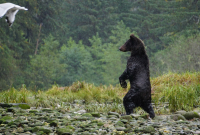Support strong Canadian climate journalism for 2025
When James Duncan of the Nature Conservancy of Canada (NCC) picked up the phone for an interview with National Observer, he couldn't contain his cheery mood.
"I'm in a pretty happy place," he said, pardoning himself for a cheesy pun referencing the Happy Valley Forest near Toronto, where he made a surprising conservation announcement earlier that day.
"In settled southern Ontario, there is virtually nowhere that wasn't essentially clear-cut over the last couple of hundred years," he explained. "So to find a place, especially within the Greater Toronto Area, where we're a few decades away from having a true old-growth upland forest, is almost unheard of... that's something incredibly special."
On Wednesday, the NCC officially purchased one of the most biologically-rich areas of the Happy Valley Forest, the largest remaining intact upland deciduous forest in Canada. The ecosystem is located in the spectacular Oak Ridges Moraine, only 45 minutes from the heart of the country's most populated city.
The newly-purchased properties — Glen Echo and Deep Woods — add more than 110 acres to existing protected areas and feature ancient trees more than 300 years old, which are home to provincially and federally-identified rare species, like the Acadian flycatcher, cerulean warbler and Jefferson salamander. Their purchase will help the NCC expand a "crucial wildlife corridor" that reaches north to the Pottageville Swamp, said Duncan, the NCC's regional vice-president for Ontario.
The organization's mandate of "forever," also ensures permanent protection from urban development and guarantees the forests will be there to reduce the carbon emitted by thousands of vehicles driving past the Happy Valley Forest each day.

Fighting the impacts of climate change
"This is right next to one of the busiest highways in the Greater Toronto Area," Duncan explained. "This forest is critical in sequestering the carbon from exhaust of those cars."
The Happy Valley Forest includes roughly six square kilometres of beautiful old-growth forest north of Toronto, and is defined by mature maple sugar and beech trees. It protects the headwaters of streams that lead to Lake Simcoe to the north, and Lake Ontario to the south, and is the only area near the major city with such a thriving old-growth forest.
The conservation organization has been working to protect the area for more than a decade, not only as a popular attraction for hikers and nature lovers, but as a vital part of its efforts to mitigate climate change as well. NCC estimates the economic value of the forest to society at roughly $20,000 per hectare each year, half of which is the value of its carbon storage.
"While we acknowledge that greenhouse gas reductions are critically important, we can't lose sight of the existence of our forest systems, especially in southern Ontario where it is so fragmented," he said. "We have areas in southwestern Ontario with less than three per cent forest cover, so every one of those existing forests is critical to maintain."
Without Wednesday's purchase, Duncan added, these two new properties would likely have become residential areas for Toronto, King, or Vaughan. Their conservation was celebrated on Wednesday with a representative from the federal government, the family of the late Ian Dalton, and other private donors who supported the purchase.
Last month, through similar donations, the NCC also purchased four private parcels of land in British Columbia's Great Bear Rainforest, the largest coastal temperate rainforest left on Earth.
This report was made possible thanks to reader subscriptions. Please subscribe today.






Comments